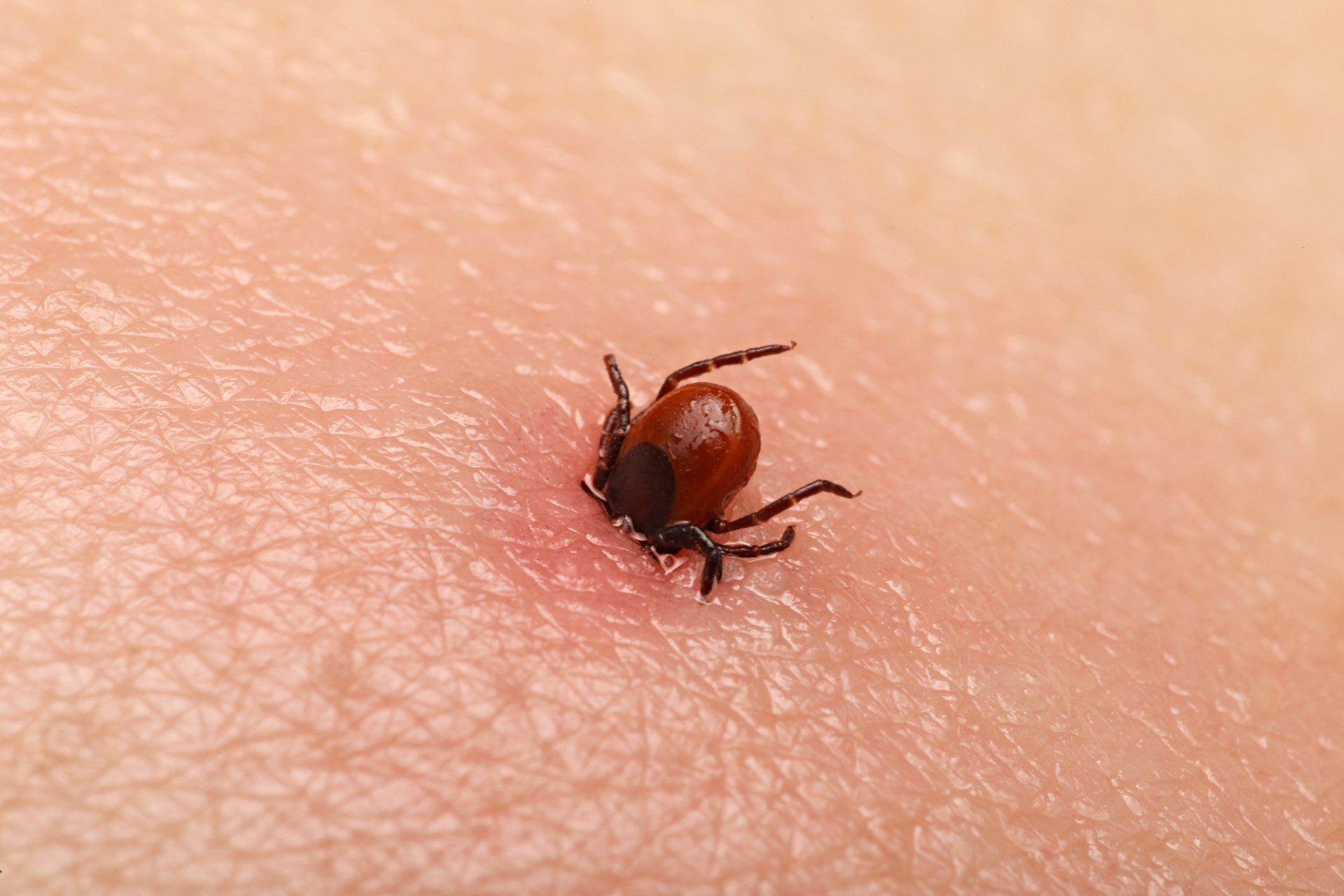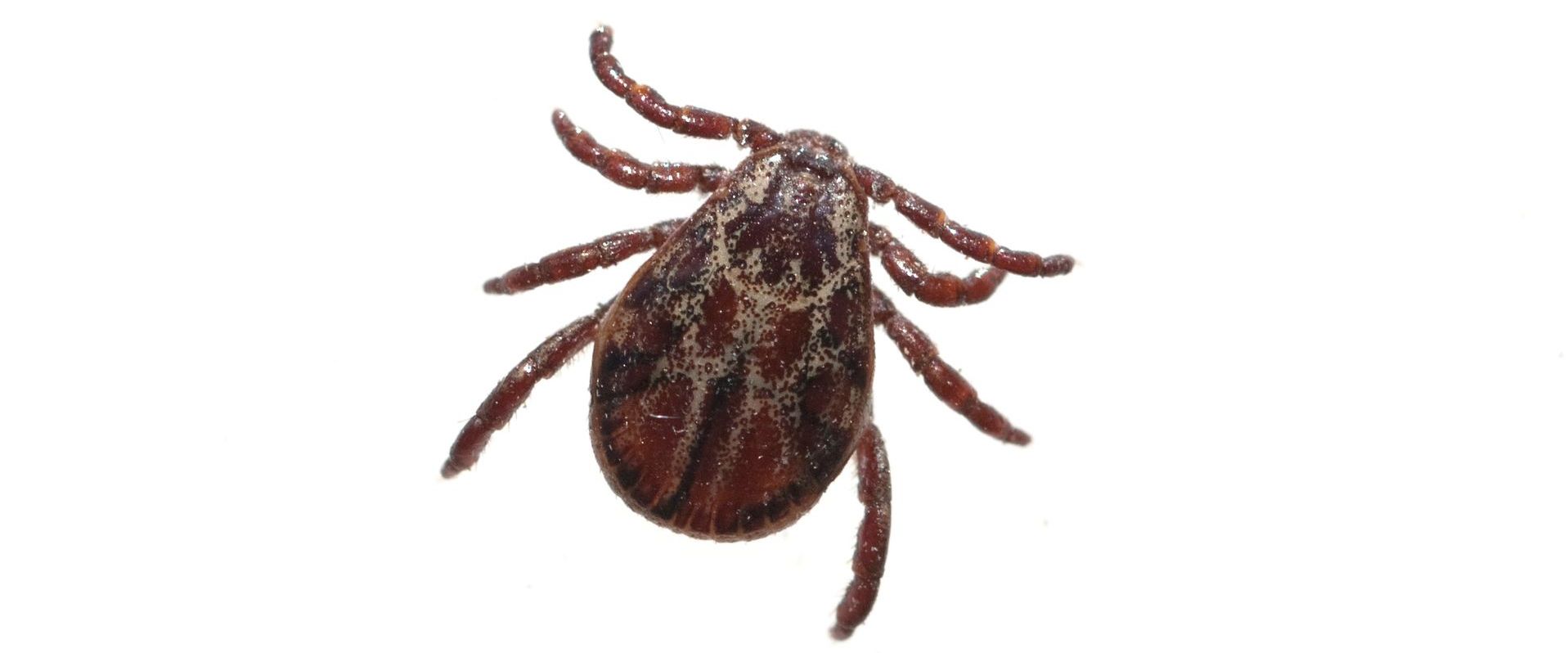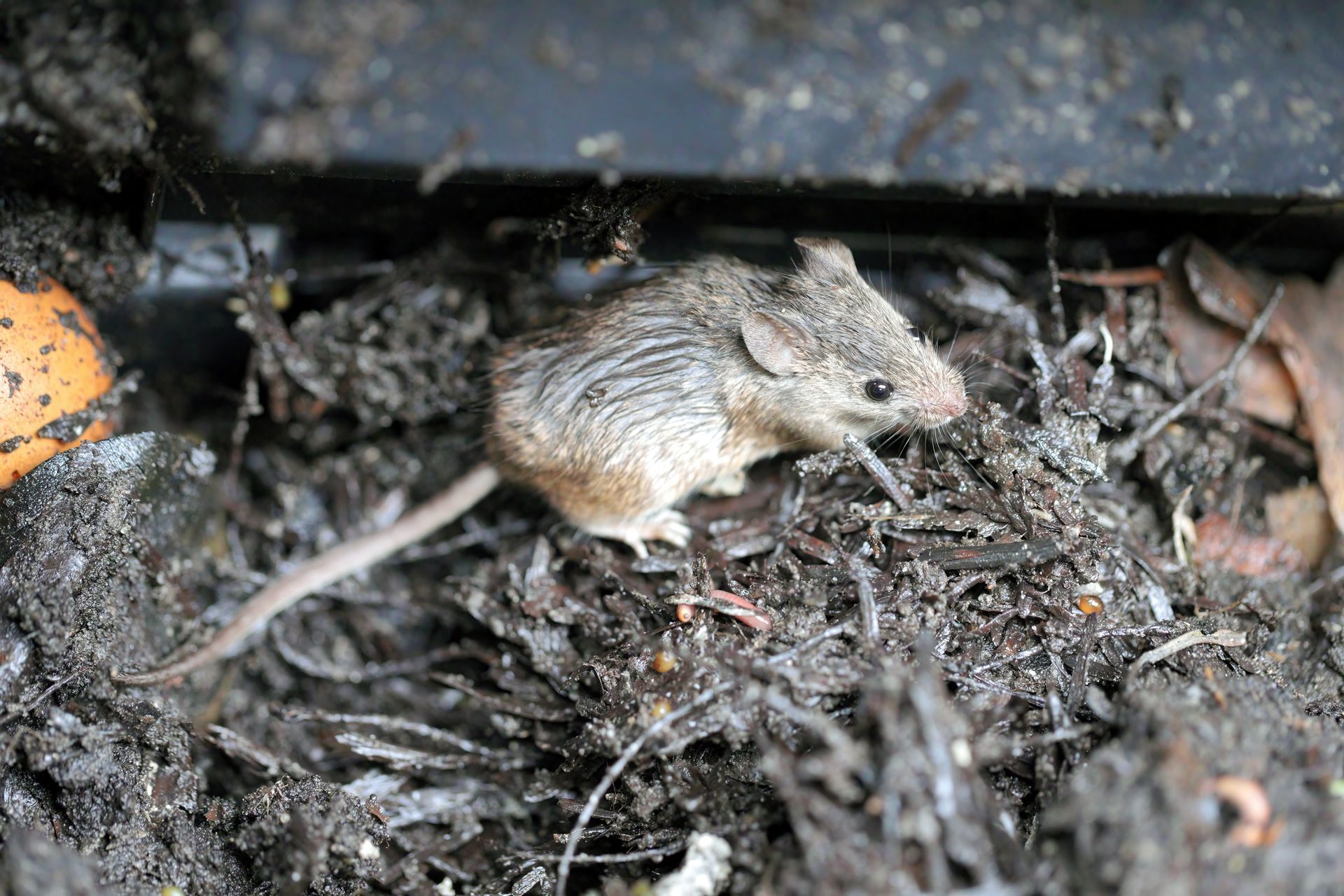What Does a Tick Bite Look Like?

Tick bites occur when outdoor activities like hiking or hunting are done in shady, damp environments. The overhanging branches that provide shade are also the perfect bridge that ticks use to latch onto passing hosts like wild animals and humans before they bite them. When a tick bites, they will leave a small, red bump on the skin that can develop further into a rash. This may not be immediately noticeable, as ticks are tiny, and their bites usually don't cause pain or itching right away. This is a result of ticks releasing an anesthetic into the skin while feeding. Once engorged, they will detach themselves and fall off without drawing attention. Recognizing a tick bite after it occurs is crucial because ticks can transmit diseases serious diseases that can have long lasting impacts on the body. Early detection is important because many tick-borne illnesses require immediate intervention to effectively treat them. In serious cases tick bites that go untreated can lead to serious health issues that affect the brain, heart, and nervous system. Consulting with a healthcare provider following a suspected tick bite ensures appropriate steps are taken to address potential health risks.
What are Ticks?
Ticks are small, eight-legged arachnids that are closely related to spiders and mites. Unlike other arachnids, ticks are known for feeding on the blood of humans and animals. They are commonly found in damp, cool, wooded environments and are most active from spring to fall. Their activity can vary based on the region and environmental conditions with ticks in warmer regions remaining active all year round.
What Do Ticks Look Like?

Ticks exhibit varied appearances based on their species, life stage, and sex. Depending on the species of tick, they can be grayish-white, brown, black, reddish-brown, and yellowish. Size-wise, ticks can be as small as a grain of sand in their larval stage and grow up to the size of a pencil eraser as adults. Their size is also largely dependent on if they have fed. After a tick bites their host, they will fill with blood and increase dramatically in size after a blood meal. The difference in size depends on the species but they can grow from the size of a sesame seed to the size of a grape.
What Do Tick Bites Look Like?
The most definitive sign of a tick bite is finding the tick still attached, as they can remain latched onto the skin for hours to days while feeding. However, if the tick is no longer there, the tick bites symptoms can manifest in various ways. They often show up as a small, dark dot that is surrounded by a slightly raised red bump with a hard center. Normal tick bite symptoms will start to fade after a few days, but symptoms can also get worse over time. In some cases, the tick bite can develop into a rash that could indicate a more serious infection. A distinctive feature of tick bites associated with Lyme disease, is a rash that resembles a bullseye that appears 3-14 days after the bite.
The appearance of tick bites can also vary based on the individual's reaction and the type of tick. Some people might experience allergic reactions which can cause significant swelling, redness, and itchiness. Sometimes the tick bite site can form a crusty, dry scab as part of the wound-healing process. The size and visibility of this mark can depend on the size of the tick, with larger ticks leaving more noticeable signs. In contrast, bites from smaller ticks might be too small to spot with the naked eye.
Tick Bites vs Other Insect Bites
Differentiating tick bites from other insect bites can be challenging, but certain characteristics of tick bites stand out during insect bite identification.
- Other insect bites often result in pus or fluid filled blisters which are not common with tick bites.
- The location of a tick bite can also be a giveaway. Tick bite locations can be found in areas that are shared with fleas, mosquitoes, and bed bugs but insect bites that occur on the back of the neck, shoulders, and scalp are typically unique to ticks.
- The number of bites can provide clues as bites from fleas, bed bugs, and mosquitoes often occur in multiples whereas ticks typically latch on and bite in a singular location.
- Tick bite sites may also be more pronounced than other insect bites as they burrow their heads into the skin before feeding. Other insects usually use a thin proboscis to draw blood which doesn’t cause the same amount of trauma to the bite site.
It's important to remember that these differences are not designed to provide guidance when determining the type of insect bite and seeking professional medical attention is still recommended if a tick bite is suspected.
Identifying Tick Bite Rashes
Another clear indicator of tick bites is if they develop further into a rash. When this happens, it could be an indicator that the tick passed on a more serious infection like Lyme disease and Bartonellosis. Identifying tick bite rashes is crucial for early detection of potential infections. The most recognized rash associated with tick bites is erythema migrans which is commonly known as the bull’s-eye rash. This distinct rash typically features a central red spot surrounded by a clear ring and another ring of redness which resembles a target. On darker skin tones, this redness may appear as a deeper, red-toned brown that differs from the person's usual skin color. In some instances, the rash may also show bruising around the bite area.
Apart from Lyme disease, other tick-borne illnesses like Bartonellosis can manifest in a different type of rash. These rashes often appear in a streaked pattern that look like deep red stretch marks, like those that appear due to pregnancy or rapid weight gain. The streaks are usually red or dark brown and do not align with the natural lines of the skin. Recognizing these varying presentations of tick bite rashes can be a vital step in seeking timely medical consultation and treatment.
How Long Do Tick Bites Appear For?
The duration of a tick bite's visibility varies based on individual reactions and the potential presence of infection. Typically, a tick bite might cause a small, red skin reaction which can persist for days or even weeks. This reaction alone doesn't necessarily signify an infection but should be regarded as a potential indicator of tick exposure. In the case of Lyme disease, an erythema migrans rash can develop over the first 3 - 14 days and grow in size over time.
What Do Tick Bites Feel Like?
Tick bites are often imperceptible at the moment they occur because ticks inject an anesthetic into the skin upon biting. This numbs the area and makes tick presence unnoticeable while they continue to feed for several hours to days. Due to this, many individuals do not realize they have been bitten by a tick until later, if at all. The absence of immediate pain or discomfort is why it's crucial to regularly check for ticks after spending time in areas where they are prevalent. This lack of sensation at the bite site also explains why many people that suffer from tick-borne diseases like Lyme disease don’t recall getting bitten.
Are Tick Bites Itchy?
Tick bites can sometimes induce itching in certain individuals that are sensitive or have an allergic reaction to the toxins and irritants present in the tick's saliva. However, this itching sensation is not a guaranteed response, as many people do not experience any immediate discomfort following a tick bite. This variability in reaction underscores the importance of thoroughly checking one’s body for ticks after spending time in areas known for tick infestations, as the absence of itching does not necessarily mean the absence of a tick.
Where to Look for Tick Bites
Conducting a thorough body check is essential after spending time in areas where ticks are common, as these pests tend to gravitate towards warm, moist areas of the body. Ticks can attach themselves to various parts of the body before migrating to areas that provide them with better coverage or better access to a blood vessel. Here are common locations to inspect for tick bites:
- Armpits
- Groin
- Hair
- Back of the Knees
- Inside the Belly Button
- Around the Waist
- Inside and Around the Ears
- Shoulders
- Neck
How to Remove a Tick
Removing a tick promptly and correctly is crucial to minimize the risk of disease transmission. If you discover a tick embedded in the skin, follow these steps for safe removal:
- Avoid Using Substances: Refrain from applying caustic substances on the tick.
- Avoid Heat Sources: Do not use matches or any other hot material to remove the tick.
- Use Pointed Tweezers: Carefully grasp the tick as close to the skin's surface as possible with fine-tipped tweezers.
- Steady, Even Pull: Gently pull upward with constant, even pressure. Avoid twisting or jerking the tick to prevent mouth parts from breaking off and remaining in the skin.
- Handle Breakage Carefully: If the tick's body breaks apart, attempt to remove the remaining parts with tweezers or seek medical help for removal.
- Listen for a 'Pop': A 'pop' sound may indicate the tick has been successfully removed.
- Preserve the Tick: Place the tick in a sealed plastic bag and store it in the freezer for possible disease testing.
- Clean the Bite Site: After removal, disinfect the skin with alcohol or soap and water, and wash your hands thoroughly.
- Consider Disease Testing: If possible, have the tick tested for diseases to determine potential exposure to diseases like Lyme disease.
Remember to consult a healthcare provider if the tick was attached for an extended period or if you develop symptoms following the bite.
Tick Bite Symptoms
While many individuals may not exhibit noticeable symptoms following a tick bite, it's important to be aware of potential signs that can indicate a reaction or infection. Symptoms of a tick bite can include:
- Small Hard Bumps or Sores: These may appear at the bite site, often accompanied by redness.
- Swelling: There can be localized swelling around the area where the tick has bitten.
- Allergic Reactions: These can vary in severity, ranging from mild (such as localized swelling and inflammation at the bite site) to severe cases of anaphylaxis.
- Rash: In some cases, a rash may develop which could be indicative of a tick-borne illness.
- Flu-like Symptoms: Symptoms similar to the flu, such as fever, headache, fatigue, and muscle aches may occur. These are also potential signs of certain tick-borne diseases.
Tick Bite Treatment
Treating a tick bite effectively often involves simple at-home remedies, especially when the bite is not severe or showing signs of a tick-borne disease. To alleviate symptoms such as itching, redness, swelling, and pain associated with a tick bite, consider the following approaches:
- Oatmeal Bath: Soaking in an oatmeal bath can soothe itching and irritation.
- Cold Compress: Apply ice or a cold pack to the bite area for 15-20 minutes per hour to help reduce swelling and alleviate pain.
- Over-the-Counter Medications: Consider using anti-inflammatory or antihistamine medications to manage symptoms and itchiness.
When To Worry About a Tick Bite
While tick bites are often not a serious concern, there are certain instances when it's advisable to seek medical attention. Be alert to the following situations after a tick bite:
- Incomplete Removal of the Tick: If you are unable to fully remove the tick or its parts from the skin.
- Development of a Rash or Infection Signs: If a rash appears around the bite site or if there are signs of infection, such as redness, swelling, or warmth.
- Flu-like Symptoms: Symptoms like fever, chills, fatigue, muscle and joint pain, or a headache following a tick bite should be evaluated by a doctor.
It's not always necessary to consult a doctor after a tick bite, especially if the tick wasn't attached for a long period. However, taking a photo of the tick for later identification can be beneficial. If possible, save the tick because it can be tested to determine if it was a carrier of a tick-borne disease. Pay close attention to your health in the weeks following the bite. Symptoms of Lyme disease, for example, can take up to 30 days to appear. If any unusual or flu-like symptoms develop, it's important to inform your healthcare provider about the recent tick bite for a proper assessment and potential treatment.
Tick Borne Diseases
After a tick bite, it's crucial to be vigilant for symptoms that may indicate a tick-borne disease. These diseases typically manifest 3-30 days post-bite and can vary in severity. Common tick-borne illnesses include:
- Lyme Disease: The most prevalent tick-borne illness in the U.S that is commonly spread by deer ticks. This is characterized by fever, headache, fatigue, and a distinctive bullseye rash.
- Rocky Mountain Spotted Fever: Often transmitted by dog or wood ticks. Its symptoms include fever, headache, and skin rash. This could potentially be fatal without receiving antibiotic treatment.
- Tularemia: This disease can affect both humans and animals, with symptoms varying based on the mode of infection. It can be life-threatening if not treated promptly with antibiotics.
- Ehrlichiosis: This is spread by lone star ticks and usually comes with fever, chills, headache, muscle aches, and sometimes gastrointestinal symptoms.
- Babesiosis: This is the result of parasites that are spread by certain ticks. These parasites infect red blood cells and don’t always present symptoms.
- Alpha-gal Syndrome: This condition triggers a food allergy to red meat and other mammalian products and is spread by lone star ticks.
If you develop symptoms of tick-borne illnesses like a rash, flu-like symptoms, or other unusual signs after a tick bite, it's important to consult a doctor. Even if you've previously been treated for a tick-borne disease, reinfection is possible and requires medical attention.
Contact EcoGuard if You Are Dealing with a Tick Problem
While taking preventive measures and knowing how to respond to tick bites are crucial, managing a tick problem effectively may require professional assistance. If you're dealing with ticks or concerned about tick-borne diseases, EcoGuard Pest Management is here to help. Our team of experts offers comprehensive solutions for tick control to keep your environment tick-free. Don't let ticks become a persistent issue in your home or garden. Contact EcoGuard Pest Management for reliable and efficient pest control services to ensure the safety and well-being of your family.
Tick Bite Appearance FAQs
What does a tick bite on a human look like?
A tick bite on a human usually appears as a small red bump and may sometimes be accompanied by redness or swelling. In some cases, especially with Lyme disease, the bite can develop into a distinctive rash that resembles a bullseye. This rash has a red center where the tick bite occurred and is surrounded by a clear ring and another ring of redness. However, not all tick bites result in this specific rash, and the absence of a rash doesn't necessarily mean a tick hasn't bitten you.
How do you check yourself for tick bites?
To check yourself for tick bites, conduct a thorough body examination that focuses on warm, moist areas where ticks are likely to attach. Be sure to pay special attention to the scalp, armpits, groin, and behind the knees. Use a mirror to inspect hard-to-see areas and run your fingers through your hair and over your skin to feel for any small bumps that might indicate a tick. It's important to perform this check after spending time in areas known for ticks, such as wooded or grassy environments.

















